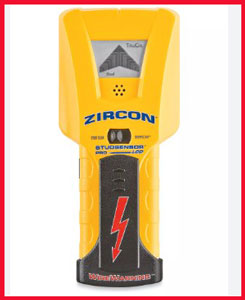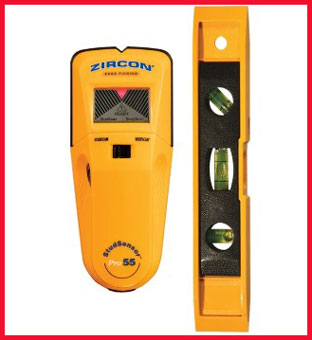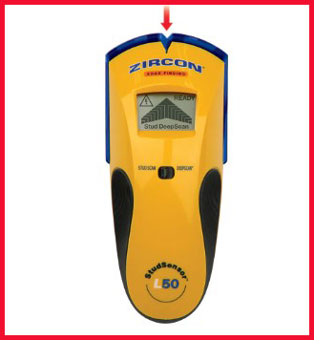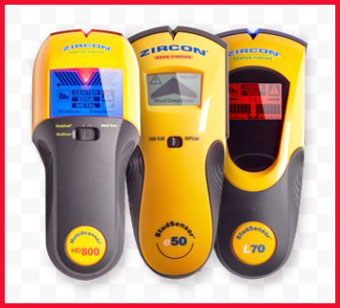I’ve spent countless weekends tackling home improvement projects, from hanging shelves to mounting TVs, and one tool I can’t live without is a reliable stud finder. After testing out the Zircon L50 and HD55, I’m here to share my experience with these two popular models to help you decide which one suits your needs. Whether you’re a DIY newbie or a seasoned pro, this article breaks down their features, pros, cons, and real-world performance in a conversational, user-focused way, so you can confidently choose the right stud finder for your next project.
Comparison Table: Zircon L50 Vs. HD55
| Feature | Zircon L50 | Zircon HD55 |
| Scan Modes | Stud Scan, DeepScan | Stud Scan, DeepScan, Metal Scan, AC Scan |
| Max Scan Depth | 1.5 inches (DeepScan) | 1.5 inches (DeepScan), 3 inches (Metal), 2 inches (AC) |
| WireWarning Detection | Yes (up to 2 inches) | Yes (up to 2 inches) |
| Display | LCD with edge indicator | Backlit LCD with edge indicator |
| SpotLite Pointer | Yes | Yes |
| Battery | 9V (not included) | 9V (not included) |
| Ergonomic Design | Pivot pinch grip | Contoured grip with V-marker |
| Price (Approx.) | $25-$30 | $30-$40 |
| Best For | Basic stud finding | Versatile scanning (studs, metal, AC) |
My Journey With Stud Finders
Read More: My Thought on True Botanicals Vs. Tata Harper

I remember the first time I tried hanging a heavy mirror without a stud finder—disaster. The drywall crumbled, and I was left with a hole and a headache. Since then, I’ve learned that a good stud finder is a game-changer for any home project. The Zircon L50 and HD55 caught my attention because they’re affordable, widely available, and packed with features that make locating studs, metal, or wires behind walls a breeze. But which one’s better for you? Let’s break it down by exploring their features, performance, and quirks through my own testing and insights.
Zircon L50: The Reliable Workhorse
The Zircon L50 is like that trusty friend who shows up when you need them but doesn’t overcomplicate things. It’s designed for homeowners like me who need a straightforward tool for occasional projects like hanging picture frames or installing shelves. Here’s what I found when I put it to the test.
Key Features of the Zircon L50
The L50 comes with two scanning modes: Stud Scan, which detects wood or metal studs up to 0.75 inches deep, and DeepScan, which doubles that depth to 1.5 inches. This is handy for thicker walls or surfaces like plaster. The WireWarning detection system, which alerts you to live AC wires up to 2 inches deep, gave me peace of mind when drilling near electrical outlets. Its LCD display is clear, showing when you’re approaching a stud edge, and the SpotLite Pointer—a bright arrow projected onto the wall—makes marking a no-brainer. The patented pivot pinch grip fits snugly in my hand, and the rubber grips ensure I don’t fumble it during use.
Pros Of The Zircon L50
- Affordable Price: At around $25-$30, it’s budget-friendly for casual DIYers.
- Ease of Use: The interface is intuitive, and calibration is quick—just hold it against the wall and press the button.
- Comfortable Design: The pivot pinch grip feels natural, even during long scanning sessions.
- Reliable for Basic Needs: It consistently found wood and metal studs in my drywall tests.
- WireWarning Feature: This saved me from drilling into a live wire near my kitchen outlet.
Cons Of The Zircon L50

- Limited Scan Modes: It only has Stud Scan and DeepScan, so it’s not ideal for detecting metal pipes or other materials.
- Battery Not Included: You’ll need to buy a 9V battery separately, which is a minor hassle.
- False Positives on Textured Walls: On my popcorn ceiling, it occasionally gave inconsistent readings, requiring multiple passes.
- No Metal or AC-Specific Modes: If you need to locate pipes or wires specifically, you’re out of luck.
In my tests, the L50 performed well on standard drywall, pinpointing studs with ease. I used it to hang floating shelves in my living room, and the SpotLite Pointer made marking the edges a breeze. However, when I tried it on a plaster wall in my older home, it struggled a bit, giving me a few false positives. Recalibrating and moving slowly helped, but it wasn’t as seamless as I’d hoped.
Zircon Hd55: The Versatile Multitasker
The Zircon HD55 feels like the L50’s more ambitious sibling, offering extra features for those who want a bit more from their stud finder. I tested it on a variety of surfaces—drywall, plaster, and even a tiled bathroom wall—to see how it stacks up.
Key Features of the Zircon HD55
The HD55 steps up the game with four scanning modes: Stud Scan (0.75 inches), DeepScan (1.5 inches), Metal Scan (up to 3 inches), and AC Scan (up to 2 inches). This makes it a versatile tool for more complex projects. Like the L50, it has WireWarning detection and a SpotLite Pointer, but its backlit LCD display is a step above, making it easier to read in dim lighting. The contoured grip with a V-marker groove feels modern and ergonomic, and the illuminated arrow on the wall is a nice touch for precise marking.
Pros Of The Zircon HD55
- Multiple Scan Modes: The Metal and AC Scan modes are a huge plus for projects involving pipes or wiring.
- Backlit Display: Perfect for working in poorly lit areas, like my basement.
- Accurate Edge Detection: It nailed the stud edges in my tests, even on trickier surfaces like plaster.
- Safety First: The WireWarning and AC Scan modes make it ideal for cautious DIYers.
- Ergonomic Upgrade: The V-marker grip feels slightly more comfortable than the L50’s pinch grip.
Cons of the Zircon HD55
- Slightly Pricier: At $30-$40, it’s a bit more expensive than the L50.
- Battery Not Included: Like the L50, you’ll need to supply your own 9V battery.
- Learning Curve: The extra modes require a bit of practice to master.
- Occasional False Positives: I noticed a few misreads on textured surfaces, though recalibrating usually fixed it.
The HD55 shone when I used it to locate metal pipes in my bathroom before installing a towel rack. The Metal Scan mode was a lifesaver, as I didn’t want to risk hitting a pipe. The backlit display was also a godsend when I was working in my dimly lit garage. However, I found the extra modes a bit overwhelming at first, and it took a few tries to get the hang of switching between them.
Head-To-Head: L50 Vs. HD55 In Real-World Use

To really understand how these two stack up, I put them through their paces on three projects: hanging a TV mount on drywall, installing shelves on a plaster wall, and checking for pipes in a tiled bathroom. Here’s what I learned.
Drywall Performance
On standard drywall, both the L50 and HD55 performed admirably. The L50’s Stud Scan mode quickly found the edges of wood studs for my TV mount, and the SpotLite Pointer made marking a breeze. The HD55 was just as accurate, but its backlit display was easier to read in my living room’s evening light. Both detected live wires near an outlet, thanks to their WireWarning systems. For basic drywall tasks, they’re neck-and-neck, but the HD55’s display gave it a slight edge.
Plaster and Lath Challenges
My 1930s home has plaster walls, which are notorious for throwing off stud finders. The L50 struggled here, giving me inconsistent readings that required multiple passes and recalibrations. The HD55, with its DeepScan mode, handled the plaster better, though it still had occasional false positives. The Metal Scan mode on the HD55 was a game-changer, as it helped me locate nails in the lath, giving me a better sense of where the studs were. If you live in an older home, the HD55 is the clear winner.
Tiled Surfaces and Metal Detection
In my bathroom, I needed to ensure I wasn’t drilling into pipes before mounting a towel rack. The L50 couldn’t help here, as it lacks a Metal Scan mode. The HD55’s Metal Scan mode detected a copper pipe about 2 inches deep, saving me from a potential plumbing disaster. The AC Scan mode also confirmed no live wires were in the area, which gave me extra confidence. For projects involving tile or metal, the HD55 is the only option of the two.
Ease of Use and Ergonomics
Both tools are designed with comfort in mind, but they feel different in hand. The L50’s pivot pinch grip is solid for quick jobs, but I found the HD55’s contoured V-marker grip more comfortable for extended use. The HD55’s backlit display and illuminated arrow also made it easier to use in tricky lighting. However, the L50’s simplicity makes it more approachable for beginners who don’t want to fiddle with multiple modes.
Price vs. Value
The L50 is typically $5-$10 cheaper than the HD55, which might sway budget-conscious buyers. But the HD55’s extra modes and versatility make it worth the slight premium if you tackle diverse projects or work with non-standard walls. For occasional use, the L50 gets the job done without breaking the bank.
My Testing Insights And Tips
After using both stud finders extensively, I picked up a few tricks to get the most out of them. First, always start with a fresh 9V battery—low power can lead to inaccurate readings. Second, calibrate on a known stud-free area of the wall to avoid “over-the-stud” errors, which both devices warn about. Third, move slowly and steadily; rushing can cause false positives, especially on textured surfaces. Finally, if you’re working on plaster or lath, consider using the HD55’s Metal Scan mode to find nails or screws, which can indicate stud locations more reliably than density-based scanning.
I also noticed that both devices perform best on smooth, consistent surfaces like drywall. On textured walls or ceilings, you’ll need patience and multiple scans to confirm results. The HD55’s extra modes give it an edge in these scenarios, but the L50 is still a solid choice for simpler tasks.
Who Should Choose the L50?

The L50 is perfect for casual DIYers who mainly work with drywall and need a reliable, no-frills stud finder. If you’re hanging pictures, mirrors, or lightweight shelves, this tool has everything you need at a budget-friendly price. Its simplicity and ease of use make it ideal for beginners, and the WireWarning feature adds a layer of safety for basic projects.
Who Should Choose the HD55?
The HD55 is the better pick for those who tackle a variety of projects or work with challenging surfaces like plaster, tile, or lath. Its Metal and AC Scan modes make it a versatile tool for detecting pipes, wires, or metal studs, which is crucial for renovations or installations in older homes. If you value the backlit display and are willing to spend a bit more, the HD55 offers excellent value for its added functionality.
My Verdict: Which One Wins?
After testing both, I lean toward the HD55 for its versatility and superior performance on non-standard walls. Its Metal and AC Scan modes saved me from potential mishaps, and the backlit display was a nice touch for working in dim conditions. However, the L50 is a fantastic choice if you’re on a tight budget or only need a stud finder for basic drywall projects. Ultimately, your choice depends on your project needs and how often you’ll use the tool.
For me, the HD55’s extra features make it worth the slight price bump, especially since I work on a mix of drywall, plaster, and tiled surfaces. But if you’re just starting out or sticking to simple tasks, the L50 won’t let you down. Either way, both are solid tools from Zircon, a brand I’ve come to trust for affordable, accurate stud finders.
Frequently Asked Questions (Faq)
Yes, the HD55’s Metal Scan mode can detect metal studs up to 3 inches deep, making it ideal for walls with metal framing.
Install a 9V battery, select your desired mode (Stud Scan, DeepScan, Metal Scan, or AC Scan), place the device on the wall, and press the power button to calibrate. Move slowly across the wall until the SpotLite Pointer and LCD indicate a stud, metal, or wire.
Stud Scan detects wood or metal studs up to 0.75 inches deep, while DeepScan doubles the depth to 1.5 inches, ideal for thicker walls or surfaces like plaster.
The Zircon e50 is an earlier model with Stud Scan and DeepScan modes, similar to the L50. It has an LCD display and WireWarning but lacks the HD55’s Metal and AC Scan modes.
Zircon stud finders are made with plastic and electronic components, not metal, so they don’t rust. However, avoid exposing them to moisture to protect the internal circuitry.
Accuracy depends on the surface and user technique. The Zircon HD55 is highly accurate for versatile scanning, but models like the Franklin Sensors ProSensor M210 or Bosch GMS120 offer precision for professional use, especially on complex walls.
Conclusion: Make Your Choice With Confidence
Read More: My Thought on True Botanicals Vs. Tata Harper
You’ve seen how the Zircon L50 and HD55 stack up, and I hope my experience helps you pick the right tool for your projects. If you’re after simplicity and affordability, the L50 is your go-to for basic stud finding. But if you want versatility for metal, wires, or tricky walls, the HD55 is worth the extra bucks. Whichever you choose, both will make your DIY adventures safer and smoother. So, grab your stud finder, tackle that project, and let me know how it goes!
